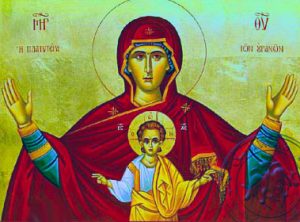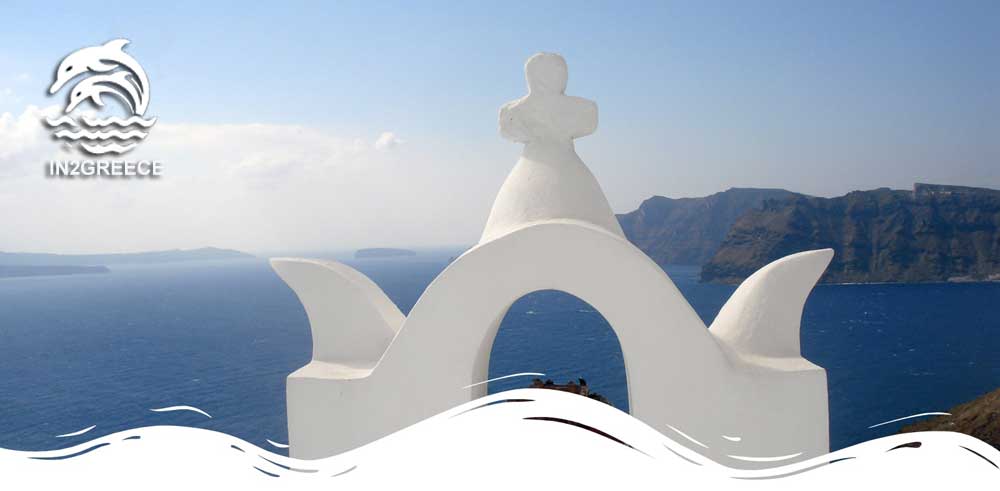Orthodox religion of Greece

A few specific characteristics of the Greek Orthodox religion is that the Virgin Mary, or Panagia , as the Greeks call her, is given great importance, the clergy is only male, priests can have wives as long as they get married before they are ordained, there are monasteries and icons are given great significance.
Easter is the most important holiday, Christmas comes second. There are various masses during Easter, but the one almost all participate in is on the Sunday. People gather at their local churches, usually outside because of the crowds, late in the evening. At midnight the priest declares “Christos anesti”, Christ has risen, and the people reply “Alithos anesti”, “truly risen”.
Then everyone light the candles they have with them from the holy flame from Jerusalem that the priest carries. After this the people go home, trying to keep the flame alive. If they make it to the doorway with the candle still burning, they make a cross in the archway, blessing the house for the following year.
Structure and Organization
The Orthodox church is a fellowship of administratively independent, or autocephalous (self-governing), local churches united in faith, sacraments, and canonical discipline, each enjoying the right to elect its own head and its bishops. Traditionally, the ecumenical patriarch of Constantinople (Istanbul) is recognized as the “first among equal” Orthodox bishops.
He possesses privileges of chairmanship and initiative but no direct doctrinal or administrative authority. The other heads of autocephalous churches, in order of precedence, are: the patriarch of Alexandria, Egypt, with jurisdiction over Africa, the patriarch of Antioch, now residing in Damascus, Syria, and heading Arab-speaking Orthodox Christians in Syria, Lebanon, and Iraq, the patriarch of Jerusalem, with jurisdiction over Palestine, the patriarch of Moscow and all Russia, the patriarch of Kiev the patriarch-catholicos of Georgia, the patriarch of Serbia, the patriarch of Romania, the patriarch of Bulgaria, the archbishop of Cyprus, the archbishop of Athens and all Greece, the metropolitan of Warsaw and all Poland, the archbishop of Albania, the metropolitan of Prague, and the archbishop of New York and North America.
Three autonomous churches also enjoy a large degree of independence, although the election of their primates is subject to nominal approval by a mother church. These are the churches of Crete and Finland, under Constantinople, and the church of Japan, under Moscow. The autocephalous and autonomous churches differ greatly in size and membership.
The churches of Russia and Ukraine (50 million members, see Russian Orthodox church) and Romania (21 million members) are by far the largest, whereas some of the ancient patriarchates of the Middle East, including Constantinople, are reduced to a few thousand members. The patriarch of Constantinople, however, also exercises jurisdiction over Greek-speaking churches outside Greece and controls, for example, the Greek archdiocese of America, which is distinct from the Orthodox church in America. In Greece the Orthodox church is the established religion.
Long repressed in the USSR and the Communist countries of Eastern Europe, it experienced renewed freedom in those areas with the downfall of the Communist regimes. Conciliarity is the principle governing the structures of the Orthodox church. The council, or synod, of bishops is the highest canonical authority in each autocephalous church, and an ecumenical council is the highest authority on the world level.
History
Historically, the contemporary Orthodox church stands in direct continuity with the earliest Christian communities founded in regions of the eastern Mediterranean by the apostles of Jesus. The subsequent destinies of Christianity in those areas were shaped by the transfer (324 BC) of the imperial capital from Rome to Constantinople by Constantine I.
As a consequence, during the first eight centuries of Christian history most major intellectual, cultural, and social developments in the Christian church also took place in that region, for example, all ecumenical councils of that period met either in Constantinople or in its vicinity.
Missionaries, coming from Constantinople, converted the Slavs and other peoples of Eastern Europe to Christianity (Bulgaria, 864, Russia, 988) and translated Scripture and liturgical texts into the vernacular languages used in the various regions. Thus the liturgy, traditions, and practices of the church of Constantinople were adopted by all and still provide the basic patterns and ethos of contemporary Orthodoxy.
These developments, however, were not always consistent with the evolution of Western Christianity, where the bishop of Rome, or pope, came to be considered the successor of the apostle Peter and head of the universal church by divine appointment. Eastern Christians were willing to accept the pope only as first among patriarchs. This difference explains the various incidents that grew into a serious estrangement. One of the most vehement disputes concerned the filioque clause of the Nicene Creed (see creed), which the Western church added unilaterally to the original text.
The schism developed gradually. The first major breach came in the 9th century when the pope refused to recognize the election of Photius as patriarch of Constantinople. Photius in turn challenged the right of the papacy to rule on the matter and denounced the filioque clause as a Western innovation. The mounting disputes between East and West reached another climax in 1054, when mutual anathemas were exchanged .
The sacking of Constantinople by the Fourth Crusade (1204) intensified Eastern hostility toward the West. Attempts at reconciliation at the councils of Lyon (1274) and Florence (1438-39) were unsuccessful. When the papacy defined itself as infallible (First Vatican Council, 1870), the gulf between East and West grew wider. Only since the Second Vatican Council (1962Ð65) has the movement reversed, bringing serious attempts at mutual understanding.
Doctrines and Practices
The Orthodox church recognizes as authoritative the decisions of the seven ecumenical councils that met between 325 and 787 and defined the basic doctrines on the Trinity and the incarnation. In later centuries Orthodox councils also made doctrinal definitions on grace (1341, 1351) and took a stand in reference to Western teachings.
The Orthodox church accepts the early traditions of Christianity, including the same sacraments as the Roman Catholic churchÑalthough in the Orthodox church infants receive the Eucharist and confirmation and the episcopate and the priesthood, understood in the light of apostolic succession. Married men may become priests, but bishops and monks may not marry.
The veneration of Mary, as Mother of God, is central to Orthodox worship, and the intercession of saints is emphasized in the Orthodox liturgical tradition. After an early controversy on the subject (see iconoclasm), the images, or icons, of Christ, the Virgin Mary, and the saints are now seen as visible witnesses to the fact that God has taken human flesh in the person of Jesus. The liturgy used by the Orthodox church is known as the Byzantine rite.
It has been translated from Greek into many languages, including the Old Church Slavonic used by the Russian Orthodox church. The liturgy is always sung, and communion is distributed to the congregation in both kinds (bread and wine).
Monasticism, with its origins in the Christian East (Egypt, Syria, Cappadocia), has since been considered in the Orthodox church as a prophetic ministry of men and women, showing through their mode of life the action of the Holy Spirit. The monastic republic of Mount Athos, Greece, is still viewed among Orthodox Christians as a center of spiritual vitality.
The Orthodox church has been generally quite open to the contemporary ecumenical movement. One by one, the autocephalous churches have all joined the Protestant-initiated World Council of Churches, without modifying their own view on Christian unity, but considering the council as an acceptable forum for dialogue and cooperation with other Christians.
Recent steps taken by the Roman Catholic church and the decrees of the Second Vatican Council were seen by the Orthodox as promising groundwork for the future. This positive reaction led an ongoing dialogue between Orthodox and Catholic leaders. New conflicts arose in the 1990s however, when Eastern Rite Catholicism (suppressed during the Soviet period) reemerged to rival the Orthodox church in Ukraine and other eastern European countries.
